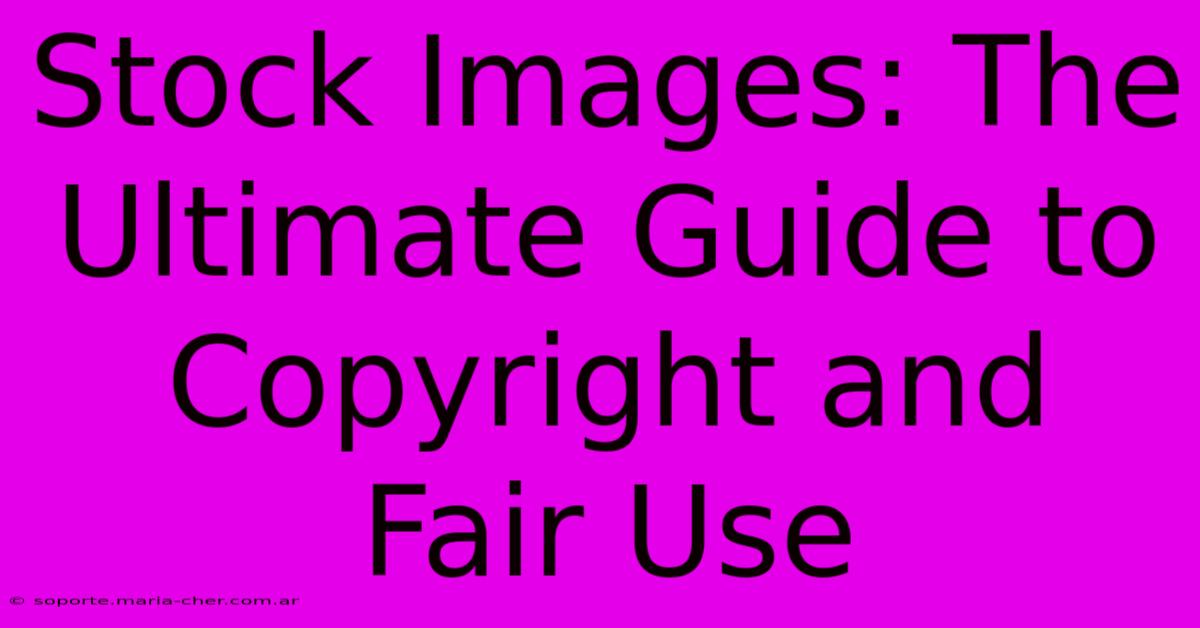Stock Images: The Ultimate Guide To Copyright And Fair Use

Table of Contents
Stock Images: The Ultimate Guide to Copyright and Fair Use
Using stock images can dramatically enhance your website, blog, social media, or marketing materials. But navigating the complex world of copyright and fair use can be tricky. This comprehensive guide will equip you with the knowledge to use stock images legally and ethically, avoiding costly mistakes and protecting your brand.
Understanding Copyright and Stock Photos
Before diving into fair use, let's clarify copyright. When a photographer takes a picture, they automatically own the copyright. This grants them exclusive rights to reproduce, distribute, display, and create derivative works from their image. Stock photo websites license these rights, not sell them outright. This means you're paying for a license to use the image under specific conditions, not for permanent ownership.
Types of Stock Photo Licenses:
- Royalty-Free: This is the most common type. You pay a one-time fee for a license to use the image, usually with limitations on usage (e.g., print runs, website views). You don't pay royalties each time you use it.
- Rights-Managed: These licenses are more restrictive and often more expensive. They typically involve negotiating usage rights (e.g., exclusivity, territory, duration) with the copyright holder. They are often preferable for large-scale commercial projects.
- Creative Commons: Some images are available under Creative Commons licenses, which grant varying degrees of usage rights. Always carefully review the specific license terms before using the image. Attribution is often required.
Navigating Fair Use: When Can You Use Stock Images Without a License?
Fair use is a legal doctrine in the United States (and similar doctrines exist in other countries) that allows limited use of copyrighted material without permission from the copyright holder. However, it's a complex area and it's crucial to understand that fair use is a defense, not a right. You might still be sued, even if you believe your use is fair. Therefore, always prioritize obtaining a license.
Factors considered when determining fair use include:
- Purpose and character of use: Is the use for commercial or non-profit educational purposes? Transformative uses (e.g., using an image in a satirical context) are more likely to be considered fair use.
- Nature of the copyrighted work: Is the work factual or creative? Creative works are afforded greater protection.
- Amount and substantiality of the portion used: Using only a small portion of the image is more likely to be considered fair use than using the entire image.
- Effect on the market: Does your use harm the potential market for the original work? Using a stock image instead of commissioning a similar image could potentially be seen as harmful.
Examples of situations where fair use might (but may not!) apply:
- Criticism and commentary: Using a stock image to illustrate a review or critique of a product. However, using the entire image might not be considered fair use.
- News reporting: Using a stock image to accompany a news story. Again, the context and amount used are crucial.
- Parody: Transforming an image in a comedic or satirical way. This needs to be clearly transformative, not just using the image for illustrative purposes.
Caution: Even in cases where fair use might seem to apply, the legal landscape is constantly evolving. The safest approach is always to obtain the appropriate license from the copyright holder or a reputable stock photo website.
Best Practices for Using Stock Images Legally:
- Choose reputable stock photo websites: Sites like Shutterstock, Getty Images, iStock, Adobe Stock, and Unsplash (for free, often with restrictions) provide clear licensing terms.
- Carefully review the license: Understand the limitations of the license before using the image. Pay attention to permitted uses, print resolutions, and attribution requirements.
- Keep records: Maintain records of your purchases and licenses to demonstrate compliance.
- Properly attribute the image (if required): Always follow the attribution requirements specified in the license.
- Don't alter the license: Don't attempt to circumvent license restrictions.
- Consider the image's context: Ensure the image aligns with your brand and message, and doesn't misrepresent information.
Conclusion: Protecting Yourself and Your Brand
Using stock images effectively can significantly enhance your content. However, respecting copyright and understanding fair use is crucial to avoid legal trouble and maintain your brand's integrity. By carefully reviewing licenses, choosing reputable sources, and following best practices, you can confidently use stock images to elevate your projects while adhering to the law. Remember, when in doubt, always obtain a license. The cost of a license is far less than the potential cost of a copyright infringement lawsuit.

Thank you for visiting our website wich cover about Stock Images: The Ultimate Guide To Copyright And Fair Use. We hope the information provided has been useful to you. Feel free to contact us if you have any questions or need further assistance. See you next time and dont miss to bookmark.
Featured Posts
-
Unveil The Secrets Of Blockchain The Block That Changed Everything
Feb 09, 2025
-
Spine Chilling Surgery Unlocking The Price Tag Of Spinal Fusion
Feb 09, 2025
-
Discover The Nail Gel Revolution Unlocking Salon Quality Manicures At Home
Feb 09, 2025
-
Supercharge Your Writing The Split Sentence Game Changer
Feb 09, 2025
-
Revolutionizing Photography Canon Rf 35mm F 1 2 A Beacon Of Innovation
Feb 09, 2025
